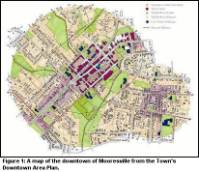Welcome to the Federal Highway Administration's (FHWA) Visualization in Planning website. Here you can learn about noteworthy practices and innovative uses of visualization for transportation planning, and who to contact in FHWA about questions or issues on visualization in planning.
What is Visualization in Planning?

To strengthen public participation in the planning and project delivery process and specifically to aid the public in understanding proposed plans, SAFETEA-LU calls for States and MPOs to use visualization techniques. Through visual imagery, the complex character of proposed transportation plans, policies and programs can be portrayed at appropriate scales -- state, region, local area, project architecture, etc. and from different points of view. "The effective presentation of projects' impacts to the public has become an increasingly essential part of the planning and design of transportation" system.
Examples of visualization techniques include sketches, drawings, artist renderings, physical models and maps, simulated photos, videos, computer modeled images, interactive GIS systems, GIS based scenario planning tools, photo manipulation and computer simulation.
New technology has changed the communication process. Providing visual images to a broader audience has become easy, fast and high quality. Visualization can provide the public and decision makers a clear idea of the proposed policies, plans and Transportation Improvement Programs and the impacts to the human and natural environment. Visuals can make information instantly or intuitively understandable. The new technology has made it possible to communicate what the proposals may look like when implemented. Public involvement techniques such as visual preference surveys and scenario planning tools improve consensus building.
- Noteworthy Practices and Innovative Uses
- Eastern Federal Lands Highway Division Design Visualization
- NETC 00-6: Effective Visualization Techniques For The Public Presentation Of Transportation Projects
- TRB's Visualization in Transportation
- AASHTO's Visualization in Transportation; A Guide for Transportation Agencies